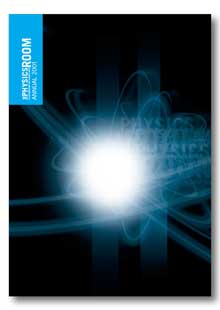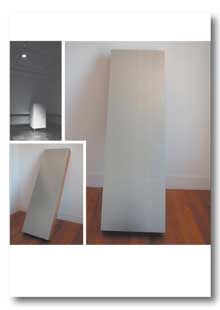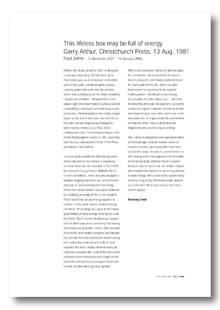 |
|||||||||
|
|
| ...Publications: Annual | ...Paul Johns | ||||||
|
This
lifeless box may be full of energy Garry Arthur, Christchurch
Press, 13
Aug. 1981 Amidst the hectic period of 2001 ending and a new year beginning, Christchurch artist Paul Johns gave us an enigmatic and restful work in the quiet, contained gallery space. Leaning against the wall near the window, Johns had carefully placed his newly completed "orgone accumulator". Resplendent in the natural light, the sheer metallic surface covered a beautifully crafted and polished tongue-and-groove box. Shedding light on this oddly elegant object at the end of the room, was the title of the work and accompanying photograph -both making reference to a Paul Johns’ collaborative show The Emotional Plague at the Robert McDougall Art Gallery in 1981, and more specifically a subsequent article in The Press by reviewer Garry Arthur. In revisiting this exhibition after twenty years, Johns returned to his interest in orgonomy, as researched and documented in the 1930s by controversial psychiatrist Willhelm Reich. In both exhibitions, Johns has also engaged a broader ongoing interest in our varied human attempts to somehow transform the body. Reich (like many modern new agers) believed in a unifying principle of life. In his research, Reich found that sexual energy appears to function in the same way as creative energy. For Reich, this energy was equal to the newly quantifiable unifying energy to be found in all life forms. Reich named his discovery ‘orgone’, and set about ways of accumulating it for healing and energising purposes. Hence, after decades of scientific and medical progress and despite the fact that Reich was jailed after experimenting with radioactive material which didn’t heal anybody, the web is today home to many an orgone accumulator site. It seems the concurrent alienation from institutionalised religion in the twentieth century has encouraged individuals to seek out alternative spiritual options. With a self-confessed interest in altered states, it is no wonder Johns would find intrigue in Reich’s research. And having suffered illness for many years of his life, Johns has also been drawn to orgonomy for its reputed healing powers. Building his own energy accumulator for This lifeless box…, the artist followed the principles of orgonomy, using the conducive organic materials of wool and steel wool layered upon each other within the metal and wood box. It is apparently this combination of materials that is key in attracting and heightening the positive orgone energy. Paul Johns’ investigations into orgonomy reflect an increasingly common human desire or need to combine spirituality with some kind of scientific basis, as well as current trends in self-healing and a new approach to the health of mind and body. Whether Reich’s orgone theory is science fact or not, he remains a figure who devoted his research to optimising positive human energy, with a view to the synchronicity of every living thing. And those ideas, dreamt up in the first half of last century, still hold a certain appeal. Rosemary Forde This essay originally appeared in The Physics Room Annual
2001 Order your copy today from The
Physics Room !
|
||||||


